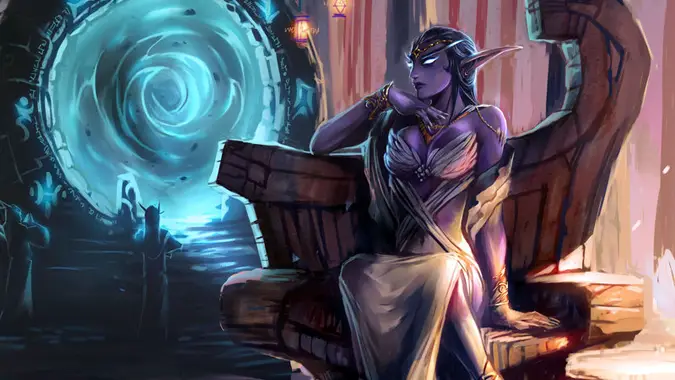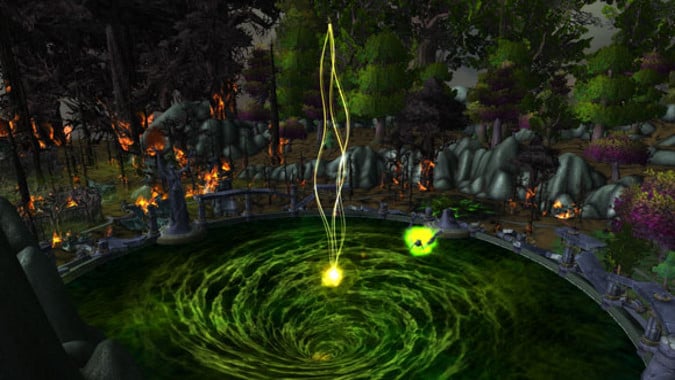Know Your Lore: The Kaldorei’s origins and beginnings

Many races have at one time or another created vast empires on Azeroth. The ancient Aqir, ancestors to the Qiraji and Nerubians (as well as the more distant Mantid), waged war against the Troll empires of the Gurubashi and Amani. The Mogu carved an empire out of the southern reaches of ancient Kalimdor, with support from the Zandalari. Each of these nations had a profound impact on Azeroth as a whole. Yet none can match the impact that the Kaldorei, the Children of the Stars, can be said to have had. For the Kaldorei, the Night Elves, actually profoundly changed the very surface of the planet.
Until 10,000 years ago Azeroth was home to the super-continent of Kalimdor. It dominated much of the world, and the lands today known as Northrend, the Eastern Kingdoms, Pandaria, and Kalimdor were all part of it. Where the Maelstrom now sits was an enormous inland lake, and this lake, known by us as the Well of Eternity, changed many who came into contact with it. While Trolls squabbled with Aqir, while dragons watched over their portfolios, and the Mogu enslaved the Jinyu, Hozen, and Pandaren, one people came forth from the darkness and were changed forever by its magic.
The Children of the Stars
There are sources that say that the Kaldorei are descended from a race of Trolls who discovered the Well of Eternity, and were forever changed by it. This is not a popular theory among the Night Elves themselves. These Dark Trolls are vanishingly rare today, and when last seen during the Third War they were unlikely to speak much on the subject, but it is known that a tribe of Dark Trolls, namely the ShadowTooth Clan, fought alongside the Night Elves against the Burning Legion. It is rumored that they were eliminated by the Twilight’s Hammer during their siege of Mount Hyjal, and if any know otherwise, none have spoken.
Nevertheless, the nascent Night Elves arose in a world where Troll, Aqir, and Mogu had powerful enclaves dominating vast territory. One would hardly expect this upstart race to be much of a threat to these ancient peoples. But the Mogu Empire was decadent, and fell to internal conflict that eventually allowed a slave race to overwhelm and destroy it in a vast revolution, and the Trolls and Aqir waged such unceasing war against one another that they eventually reeled away from each other, both fractured into smaller nations and tribes.
While this happened, the Kaldorei rose. Their close proximity to the Well of Eternity allowed them a mastery of arcane magic unlike anything the world of Azeroth had ever seen up until that time. The Night Elves came to their worship of Elune during this time — they believed the moon goddess lived in the Well during the day, rising at night to illuminate the darkness. Their study of the Well brought them both knowledge and power. They named themselves Kaldorei, a word meaning “Children of the Stars,” for their sensitive eyes were more comfortable under the light of the moon and the stars than that of the sun.
Eventually, the Kaldorei chose to leave the shores of the Well, to expand outward into the world around them.
The rise of the night
It’s unknown when, exactly, the ancient Night Elves first encountered the Trolls. If you subscribe to the Dark Troll theory, one could argue that they are Trolls. But when the Troll Empires met these upstarts, they reacted in a stereotypically Trollish way: they attacked them.
This proved to be a great error. Not only were these new people every bit as physically powerful as Trolls (themselves a large and strong people), but they had a mastery of arcane magic completely unknown to the Trolls. Trolls who depended on the divine magic of the Loa alone could not match Night Elves who prayed to Elune and could summon forth the raw arcane might of the Well to smite their foes. The Gurubashi and Amani Empires had survived the war with the Aqir, bloodied but unbowed, and each empire had still harbored ambitions towards one day reuniting all of Azeroth under the Troll peoples (with Gurubashi or Amani ascendant, of course, depending on who you asked) — the Kaldorei smashed that dream to pieces in a few short years. By the time they were done, the Trolls were driven to small pockets the Night Elves weren’t interested in.
By this time, the Mogu Empire was fully embroiled in its own destruction. This left the Night Elves essentially unrivaled. They continued to expand around the shores of the Well, claiming any territory that interested them. The Zandalari, the remnant of the people who’d once ruled all Trolls, could only watch and seethe in hatred of these newcomers, their envy of the Night Elves’ power and knowledge almost palpable. For thousands of years Trolls had been, if not masters of Kalimdor, contenders for the title.
The Moonlit World
As they expanded, Night Elves came into contact with many peoples. Some they essentially ignored, such as the nomadic Tauren or the subterranean Earthen, who had nothing of interest to the Kaldorei. They met and befriended Cenarius, the powerful demigod child of Malorne and Elune herself, who found himself fond of the Night Elves for their curiosity and intelligence (even if he was wary of their obsession with the Well of Eternity and its arcane power). When the Pandaren finally overthrew the Mogu, they made peaceful contact with the Kaldorei, who had no desire to rule over anyone but themselves. In a way, the Kaldorei were a fairly inward focusing people — the night, the stars, and the mystery of the Well were their world.
Today we can still see the legacy of this period of Night Elf history. Ancient alliances, such as those with the Furbolg people, and the presence of vast ruins in such disparate locations as Seradane, Eldarath, even Duskwood’s Twilight Grove show the former extent of the Night Elven kingdom, as do ruins in Northrend’s Crystalsong Forest.
Night Elven society developed along the twin lines of religious and arcane power. The priesthood of Elune retained much of its strength, even as the Highborne became the de factor rulers of the Kaldorei. Thousands of years passed. Eventually, a girl child was born with golden eyes, considered a sign of great destiny to her people. Azshara rose to the throne of her people — they so loved her that they named their greatest city Zin-Azshari in her honor. And every superlative said of the Queen was true. She was beautiful — the most beautiful Night Elf in existence. She was intelligent and powerful, her grasp of her people’s hearts was acute and profound. And she was powerfully curious, a trait shared by most of her people. So very curious.
But most of all, Azshara was fascinated with the Well of Eternity.
And why not? Did it not create their people? Was it not said to be the very resting place of Elune herself, their goddess and creator? Had the study of the Well not granted the Night Elves their name, their society, the power to defeat ancient empires and rise to a position of power unheard of before they came to be? And so Azshara ordered Xavius, first and foremost among her Highborne servitors, to study the Well. To plumb the depths of its secrets as no Kaldorei had dared before. For Azshara wanted to know, more than any other Kaldorei in history had, exactly what the Well of Eternity was.
And so Azshara, in one decision, altered the destiny of Kalimdor, and indeed all of Azeroth, forever. The Legion would come. Azeroth would be sundered. The Well would be destroyed and yet live on. The Naga would come to be. All because a tribe of wanderers came to rest by the shores of an ancient lake and studied its softly glowing waters.
Please consider supporting our Patreon!
Join the Discussion
Blizzard Watch is a safe space for all readers. By leaving comments on this site you agree to follow our commenting and community guidelines.
 @MatthewWRossi
@MatthewWRossi







